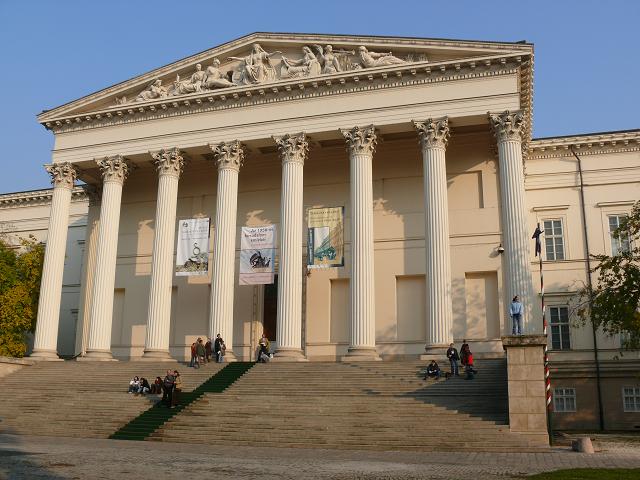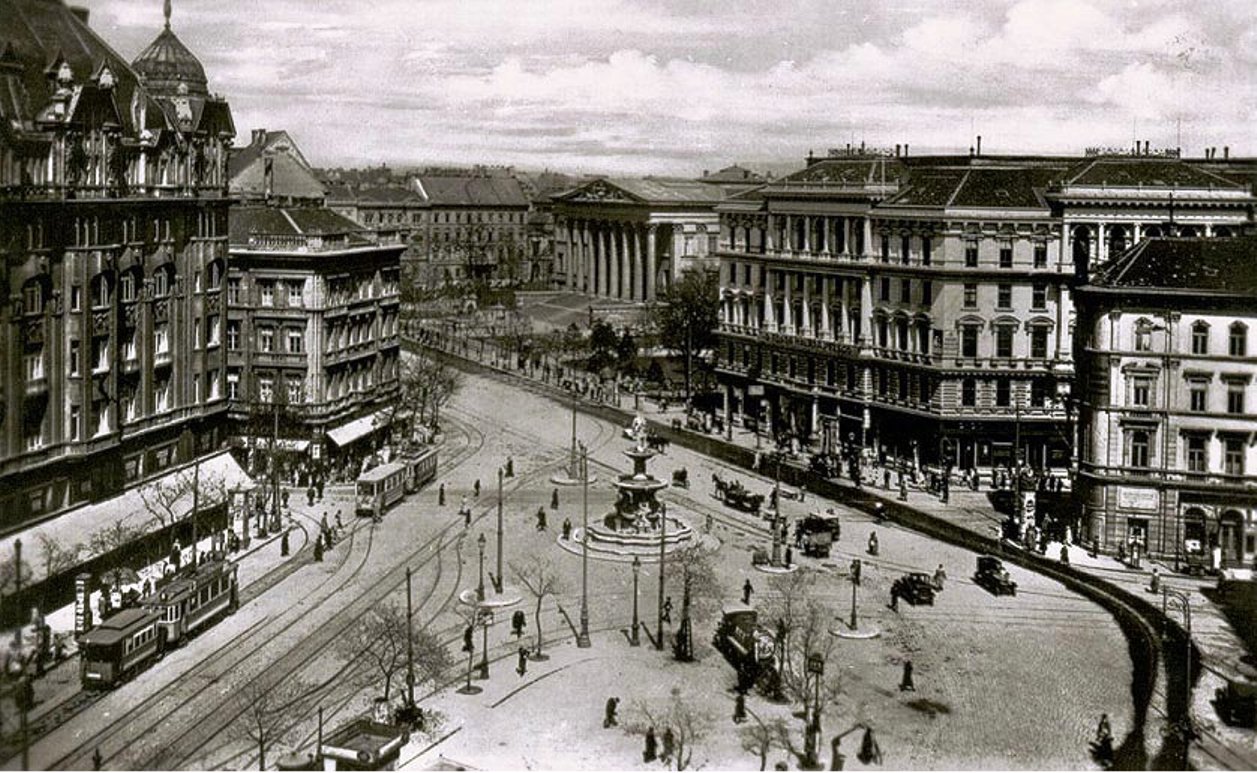|
Astoria, Budapest
Astoria is the colloquial, unofficial name of a major road intersection in the Budapest city centre and it can also refer to a station of the M2 metro line. It is named after Grand Hotel Astoria at its corner. It is the crossing point of Rákóczi út and Small Boulevard. At its corner can be found the Humanities Faculty of the Eötvös Loránd University and the Hungarian National Museum beside it. Dohány Street Synagogue The Dohány Street Synagogue ( hu, Dohány utcai zsinagóga / nagy zsinagóga; he, בית הכנסת הגדול של בודפשט, ''Bet ha-Knesset ha-Gadol shel Budapesht''), also known as the ''Great Synagogue'' or ''Tabakgasse Synagogue'', ... is located in the opposite direction, around 200 m far from this junction. Colloquially, a short section of the roads originating from the actual intersection, reachable by a few minutes of walking, can be also named Astoria (as in a neighborhood), for example "Az Astorián lakom" (I live on the Astoria ... [...More Info...] [...Related Items...] OR: [Wikipedia] [Google] [Baidu] |
Budapest
Budapest (, ; ) is the capital and most populous city of Hungary. It is the ninth-largest city in the European Union by population within city limits and the second-largest city on the Danube river; the city has an estimated population of 1,752,286 over a land area of about . Budapest, which is both a city and county, forms the centre of the Budapest metropolitan area, which has an area of and a population of 3,303,786; it is a primate city, constituting 33% of the population of Hungary. The history of Budapest began when an early Celtic settlement transformed into the Roman town of Aquincum, the capital of Lower Pannonia. The Hungarians arrived in the territory in the late 9th century, but the area was pillaged by the Mongols in 1241–42. Re-established Buda became one of the centres of Renaissance humanist culture by the 15th century. The Battle of Mohács, in 1526, was followed by nearly 150 years of Ottoman rule. After the reconquest of Buda in 1686, the ... [...More Info...] [...Related Items...] OR: [Wikipedia] [Google] [Baidu] |
Astoria (Budapest Metro)
Astoria is a station of the M2 (East-West) line of the Budapest Metro, under the eponymous square, Astoria. The station was renovated in 2003–4. It was open on 2 April 1970 as part of the inaugural section of Line M2, between Deák Ferenc tér and Örs vezér tere. Connections * Tram ** ''Deák Ferenc tér – Városház tér'' ** ''Deák Ferenc tér – Savoya Park'' ** ''Deák Ferenc tér – Kelenföld vasútállomás'' * Trolleybus ** ''Zugló vasútállomás – Orczy tér'' **74 ''Csáktornya park – Károly körút ( Astoria)'' * Bus: 5, 7, 8E, 9, 100E, 107, 108E, 110, 112, 133E References External links M2 (Budapest Metro) stations Budapest Metro stations located underground Railway stations opened in 1970 {{Hungary-railstation-stub ... [...More Info...] [...Related Items...] OR: [Wikipedia] [Google] [Baidu] |
Danubius Hotel Astoria
Danubius Hotel Astoria is a four-star hotel in the centre of Budapest, which opened on 14 March 1914. It has 138 rooms, including three suites. The hotel is managed by the Danubius Hotels Group as a member of its Classic Collection brand. It is located on the corner of Kossuth Lajos utca and Múzeum körút; the intersection is also named after the hotel. Some interior scenes from the film ''Being Julia ''Being Julia'' is a 2004 comedy-drama film directed by István Szabó and starring Annette Bening and Jeremy Irons. The screenplay by Ronald Harwood is based on the novel ''Theatre'' (1937) by W. Somerset Maugham. The original film score was comp ...'' were shot in the hotel. References External linksDanubius Hotel Astoria Hotels in Budapest Hotel buildings completed in 1914 Hotels established in 1914 1914 establishments in Hungary Belváros-Lipótváros {{hungary-hotel-struct-stub ... [...More Info...] [...Related Items...] OR: [Wikipedia] [Google] [Baidu] |
Rákóczi út
The House of Rákóczi (older spelling Rákóczy) was a Hungarian noble family in the Kingdom of Hungary between the 13th century and 18th century. Their name is also spelled ''Rákoci'' (in Slovakia), ''Rakoczi'' and ''Rakoczy'' in some foreign (English) sources. The family was named after Rákóc (Rakovec, now Rakovec nad Ondavou, Slovakia). The family originated from the Bogátradvány clan which had Bohemian roots, according to Simon of Kéza's chronicle. The foundations for the family's wealth and power were laid down by Sigismund Rákóczi; some decades into the 17th century, the Rákóczis became the wealthiest aristocrats of Hungary. Family legacy The last member of the family was György (George) Rákóczi, the son of Francis II Rákóczi, who died in France in 1756. The mysterious Count of St. Germain is believed by some to have been the son of Prince Francis (Ferenc) II Rákóczi. The ''Rákóczi March'' by János Bihari and (memorably orchestrated by Hector B ... [...More Info...] [...Related Items...] OR: [Wikipedia] [Google] [Baidu] |
Small Boulevard (Budapest)
Kiskörút or Small Boulevard (lit. "Small Ring Road") is a major thoroughfare in Budapest. It forms an incomplete semicircle between Deák Square and Fővám Square. It is the border of the southern part of District 5 (cf. Belváros), the innermost district of Pest. As opposed to Nagykörút, it only touches the Danube at its southern end. Meaning Kiskörút is actually a colloquial name for three parts which connect to each other: (from north to south) ''Károly körút'', ''Múzeum körút'' and ''Vámház körút;'' these are the names a traveller will find on the map and the buildings. Location It consists of a road with a tram line in the middle. Its width is around 55 m in the north and it narrows down to 27 m in the south. Its starting point is Deák tér in the north, it crosses Astoria and Kálvin tér, both basic points of reference for the locals, and it ends up at Fővám tér, a square next to Liberty Bridge. Among the major roads, it crosses Rákóczi út ... [...More Info...] [...Related Items...] OR: [Wikipedia] [Google] [Baidu] |
Eötvös Loránd University
Eötvös Loránd University ( hu, Eötvös Loránd Tudományegyetem, ELTE) is a Hungarian public research university based in Budapest. Founded in 1635, ELTE is one of the largest and most prestigious public higher education institutions in Hungary. The 28,000 students at ELTE are organized into nine faculties, and into research institutes located throughout Budapest and on the scenic banks of the Danube. ELTE is affiliated with 5 Nobel laureates, as well as winners of the Wolf Prize, Fulkerson Prize and Abel Prize, the latest of which was Abel Prize winner László Lovász in 2021. The predecessor of Eötvös Loránd University was founded in 1635 by Cardinal Péter Pázmány in Nagyszombat, Kingdom of Hungary (today Trnava, Slovakia) as a Catholic university for teaching theology and philosophy. In 1770, the university was transferred to Buda. It was named Royal University of Pest until 1873, then University of Budapest until 1921, when it was renamed Royal Hungarian Pázmá ... [...More Info...] [...Related Items...] OR: [Wikipedia] [Google] [Baidu] |
Hungarian National Museum
The Hungarian National Museum ( hu, Magyar Nemzeti Múzeum) was founded in 1802 and is the national museum for the history, art, and archaeology of Hungary, including areas not within Hungary's modern borders, such as Transylvania; it is not to be confused with the collection of international art in the Hungarian National Gallery. The museum is in Budapest VIII in a Neoclassical building, purpose-built during 1837–47 by the architect Mihály Pollack. History The Hungarian National Museum traces its foundation to 1802, when Count Ferenc Széchényi set up the National Széchényi Library. This would then be followed a year later by the donating of a mineral collection by Széchényi's wife. This led to the creation of the Hungarian National Museum as a general history and natural history museum, beyond being simply a library. In 1807, the Hungarian National Parliament passed legislation on the new institution and asked the nation to help donate to the museum. The Hungar ... [...More Info...] [...Related Items...] OR: [Wikipedia] [Google] [Baidu] |
Dohány Street Synagogue
The Dohány Street Synagogue ( hu, Dohány utcai zsinagóga / nagy zsinagóga; he, בית הכנסת הגדול של בודפשט, ''Bet ha-Knesset ha-Gadol shel Budapesht''), also known as the ''Great Synagogue'' or ''Tabakgasse Synagogue'', is a historical building in Erzsébetváros, the 7th district of Budapest, Hungary. It is the largest synagogue in Europe, seating 3,000 people and is a centre of Neolog Judaism. The synagogue was built between 1854 and 1859 in the Moorish Revival style, with the decoration based chiefly on Islamic models from North Africa and medieval Spain (the Alhambra). The synagogue's Viennese architect, Ludwig Förster, believed that no distinctively Jewish architecture could be identified, and thus chose ''"architectural forms that have been used by oriental ethnic groups that are related to the Israelite people, and in particular the Arabs"''. The interior design is partly by Frigyes Feszl. The Dohány Street Synagogue complex consists of the ... [...More Info...] [...Related Items...] OR: [Wikipedia] [Google] [Baidu] |
Kálvin Tér (Budapest Metro)
Kálvin tér (English: Calvin Square) is a major square and intersection in the city center of Budapest, the capital of Hungary. It was named after the French Protestant Reformer John Calvin (''Kálvin János'' in Hungarian) due to the large Reformed Church located there. The square is located in Pest at the junction of the 5th ''(Belváros-Lipótváros)'', 8th ''(Józsefváros)'' and 9th ''(Ferencváros)'' districts. Roads which converge at the square include the ' Kiskörút' (Inner Circuit, encompassing Múzeum körút ('Museum boulevard') north of the square, and Vámház körút to the south), Üllői út (' Üllő road'), Baross utca (' Baross street'), and Kecskeméti utca ('Kecskemét street'). Being a major thoroughfare and locality, the square is a major transport hub with tram, bus, and trolleybus routes serving the square. The Kálvin tér station on the M3 (North-South) line, and M4 of the Budapest Metro is located here. The Hungarian National Museum The ... [...More Info...] [...Related Items...] OR: [Wikipedia] [Google] [Baidu] |
Deák Ferenc Tér (Budapest Metro)
The Deák Ferenc square (''Deák Ferenc tér''), named for Ferenc Deák, is a major intersection and transport junction in Budapest. Károly körút, Bajcsy-Zsilinszky út, Király utca, Deák Ferenc utca, and Harmincad utca converge here. Three lines of the Budapest Metro each converge on the station under the square. Tram lines 47 and 49 also originate from the square, as well as several bus lines. Deák Ferenc tér is a popular gathering for young people. Alcoholic beverages are sold at the grassy area, and it is common for Deák Ferenc tér to be populated until the midnight hours. Deák Tér is mentioned in ''Ending Theme'', a song by Swedish progressive metal band Pain of Salvation Pain of Salvation is a Swedish progressive metal band led by Daniel Gildenlöw, who is the band's main songwriter, lyricist, guitarist, and vocalist. Pain of Salvation's sound is characterised by riff-oriented guitar work, a broad vocal range, o .... References {{DEFAULTSORT:Deak Fere ... [...More Info...] [...Related Items...] OR: [Wikipedia] [Google] [Baidu] |
Ferenciek Tere (Budapest Metro)
Ferenciek tere is a station on the M3 (North-South) line of the Budapest Metro located under the eponymous square in the Downtown. It is an important junction, as several bus lines from Buda pass through or terminate here. It is also the station closest to the geographical ''city centre'' of Budapest. The station's name was ''Felszabadulás tér'' ("Liberation" Square) before 1990. The station was opened on 31 December 1976 as part of the inaugural section of Line M3 between Deák Ferenc tér The Deák Ferenc square (''Deák Ferenc tér''), named for Ferenc Deák, is a major intersection and transport junction in Budapest. Károly körút, Bajcsy-Zsilinszky út, Király utca, Deák Ferenc utca, and Harmincad utca converge here. Three ... and Nagyvárad tér. Connections *Bus: 5, 7, 8E, 15, 107, 108E, 110, 112, 133E *Tram: 2, 2B, 23 References *Budapest City Atlas, Dimap-Szarvas, Budapest, 2011, M3 (Budapest Metro) stations Railway stations opened in 1976 Railway st ... [...More Info...] [...Related Items...] OR: [Wikipedia] [Google] [Baidu] |






